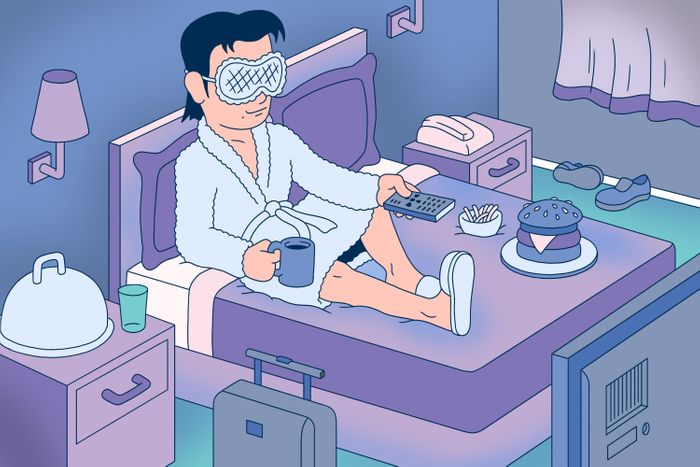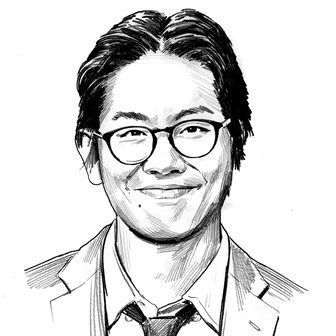
Jonathan Gold, the late great food critic, had a lovely line in a column declaring fealty to the midtown New York Hilton: “Hotel rooms are empty space yearning to be filled — with work, with sighing, with sex; cool, perfect voids screaming for completion.” The sentiment evokes possibility, a vision of the hotel room as a blank canvas. Boy, do I envy Gold’s romanticism on the matter. Hotel rooms unsettle me. When confronted with their vacant neutrality, the mind races. It thinks of the strangers in the hallway, the sounds in the bathroom, about stains and bedbugs and ghosts and the Devil. I can never get comfortable.
Sleep becomes an issue, naturally. When I started traveling somewhat frequently for work, maybe around 2016, I would simply not sleep. I spent hours tossing and turning in hotel rooms, staring at the ceiling, grumbling. Things eventually got better, in that at some point I became able to actually doze off, but not without considerable preparation and effort. I’m in good company, of course. Many travelers share the problem of hotel insomnia, even if most don’t possess my particular severity or neuroses. There are studies out there attesting to the existence of something called the “first-night effect” — that is, when a novel environment prevents the brain from fully switching so it can keep a lookout for danger. But that’s just slapping a scientistic label on what is fundamentally quotidian: You’re far from home.
My management of hotel insomnia once heavily relied on television. The move was to leave the thing on low volume at night straight through the morning, painting over the silence of the room while blocking out whatever sounds might come from outside. There’s an accompanying ritual right before bed: light snack (sometimes it’s a saltine; sometimes it’s a sandwich), shower, bathrobe. Pills are occasionally popped. Lights off, lie back, and stare in the general direction of the screen. Eyes unfocused, minimal engagement so the brain is allowed to gradually shut off. It usually takes me an hour to tip over and drift off. The television keeps going, mumbling away.
I’ve burnt through several hotel-TV sleep aids over the years. At first, the television would be parked at a local channel, which often got weird, and then at ESPN, which often got annoying. Then came HGTV, which worked so well it stuck around for several years. Of course, there’s an easy hypothesis to explain its potency: If the anxiety comes from not being home, then, duh, a channel all about homes is probably going to be a decent balm. And, you know, sure! Besides, there’s a peculiar synthetic quality to HGTV’s representation of homeyness. Watch enough of the channel in one sitting and all those houses start melding together into one subprime-mortgage aesthetic: vinyl floors, herringbone backsplash, marble counters, dark trim. It’s not home, it’s “Home.” (Let’s keep Home Town out of this, though. Those houses are homey as shit.)
Still, it worked. The HGTV vibe got me in the mood. Sleep comes.
Someone recently told me of a similar relationship she had with Guy Fieri’s Diners, Drive-ins, and Dives, or, in show and fan parlance, Triple D. Her theory about its effectiveness, though, is less about the substance than it is about simple consistency of structure. Triple D’s rhythms have stayed pretty much the same since its debut back in 2006: Fieri rolls up in a car, watches a chef prepare a dish, eats the thing, and bounces. The predictability lulls; the minor variations keep you sufficiently engaged. It is the perfect pop song. Boundaries apply, however. While her Triple D fondness is so widely known among friends that it’s become an inside joke, she mostly keeps Fieri trapped in the hotel room. The mayor of Flavortown rarely makes an appearance in her home.
I kept HGTV similarly compartmentalized, but for whatever reason, the channel stopped working as a sleep aid in 2021, when I crawled out of my pandemic bunker and started frequenting hotel rooms again. In fact, the murmurs of low-volume television more generally, once so soothing to my ears, became a stressor in their own right. Why this happened exactly, I’m not quite sure. There is the obvious hypothesis that the past three years increased my baseline anxiety and therefore completely ruined my ability to sleep at home but especially on the road, which is clearly true. I was already tightly wound before the pandemic; today, I’m a mattress coil. When confronted with the isolating hotel room now, the mind races even harder. It thinks about viruses, the coughs outside the door, the silence and stillness, and being away from the ones you love. I might even tear up at the thought of my cat.
A reliable substitute for HGTV has yet to be identified, but I’ve found some comfort by leaving my laptop plugged into a wall with a browser pulled up to anonymous corners of YouTube: rainfall recordings, lo-fi streams, ASMR camping videos — great nowhere sounds for great nowhere spaces. You can’t get more liminal than a YouTube video titled “Night Owl Jazz Cafe Ambience With Relaxing Jazz Music & Rain Sounds,” which had me out like a light the last time I was on a work trip. Beggars can’t be choosers.
These days, when staring at the ceiling around 3 a.m. in some Holiday Inn, I sometimes feel deep envy for those who spend months out of the year on the road — those frequent fliers with the lounge access who have the perfectly packed carry-on bags who probably sleep soundly wherever they go. They may or may not be happy with their nomadic state (surely they can’t all be George Clooney in Up in the Air), but they must have such a malleable sense of home. Hotel rooms are perfect voids screaming for completion, and they seem to have no problem filling that space. I wonder what it’s like to be them. Until then, I’ll always have Lofi Girl.
More From This Series
- The Bedtime Entertainment Secrets of Veteran Sleepers
- The Best Horror to Stream As You’re Falling Asleep
- The 20 Best Movies to Stream As You’re Falling Asleep


